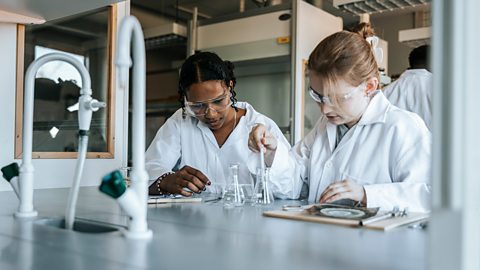Step into our online science lab and learn more about states of matter. Interact with the activity to see what happens when different substances change state.
How many states of matter are there?
There are three main states of matter: solid, liquid and gas. When a substance changes state, this is a physical change because no new substances are produced and the change is reversible.
The particles in solids, liquids and gases change arrangement and motion when a substance is heated or cooled down. This is explained by the kinetic theory of matter.
Read more about the states of matter in our study guide about temperature changes and energy.
What is happening when states of matter change?
In a system, the energy of the particles, which can be atoms or molecules, is known as the internal energy. It is the sum of the kinetic and potential energy of the particles.
Kinetic energy is due to the motion of the particles relative to each other. It increases as temperature increases.
How to calculate the energy required to raise the temperature of a substance: multiply the specific heat capacity of the substance, the mass and required temperature change.
Potential energy is due to the position of the particles relative to each other. It increases when a solid changes state into a liquid, known as fusion, or when a liquid changes state into a gas, known as vaporisation.
How to calculate the energy required to change the state of a substance: multiply the latent heat (fusion or vaporisation) and mass of the substance. There is no change of temperature during a change of state.
Sublimation occurs when a solid changes state to a gas, or a gas to a solid. This is a change of state so it changes the potential energy of the system.
Interactive activity - states of matter
Use this interactive solid to liquid to gas diagram to see what happens to the particles inside substances when they are heated and change state. Choose water, sodium chloride or iron and note how the melting and boiling points for these substances differ.
Read the descriptions in the activity to find out if there is a change in kinetic energy or potential energy at each stage of heating.
Test your understanding of the states of matter
How would you describe the change in the particle arrangement when the iron particles reach the melting point?
The particles are no longer vibrating in fixed positions. They start to slip and slide over each other.
The internal energy of the water is increasing when it reaches the boiling point, but is this an increase in kinetic energy or potential energy?
As the water is now changing state, this is an increase in potential energy.
What is the boiling point of sodium chloride?
1465 °C
When solid sodium chloride is being heated, is there an increase in kinetic or potential energy?
As the temperature increases, there is an increase in kinetic energy.
Which parts on the heating and cooling graph show a change of state?
Sections B and D show changes of state.
Where can I learn more about states of matter and energy?
The BBC Bitesize study guide about temperature changes and energy contains videos, diagrams, graphics and more physics revision notes written to the AQA GCSE physics specification.
To help you revise on the go, BBC Bitesize and BBC Sounds have developed a series of GCSE revision podcasts, covering a wide range of GCSE physics topics. For more information about kinetic energy and potential energy, listen to the series about energy.

Where can I test my knowledge of states of matter and energy?
There are lots of ways to test yourself on AQA physics and practise your skills with Bitesize, including:
An interactive quiz about temperature changes and energy, with video feedback to aid your understanding.
A ten-question quiz on temperature changes and energy with questions focusing on states of matter.
Sample exam questions covering states of matter, with advice for multiple choice, structured, mathematical and practical questions.
Bitesize also has lots of general AQA physics test pages, including:
Exam practice quizzes based on GCSE physics past papers.
Quick-fire quizzes with different physics questions each time you return.
Topic-based exam practice questions based on past papers, allowing you to choose the AQA GCSE physics topic you want to focus on.